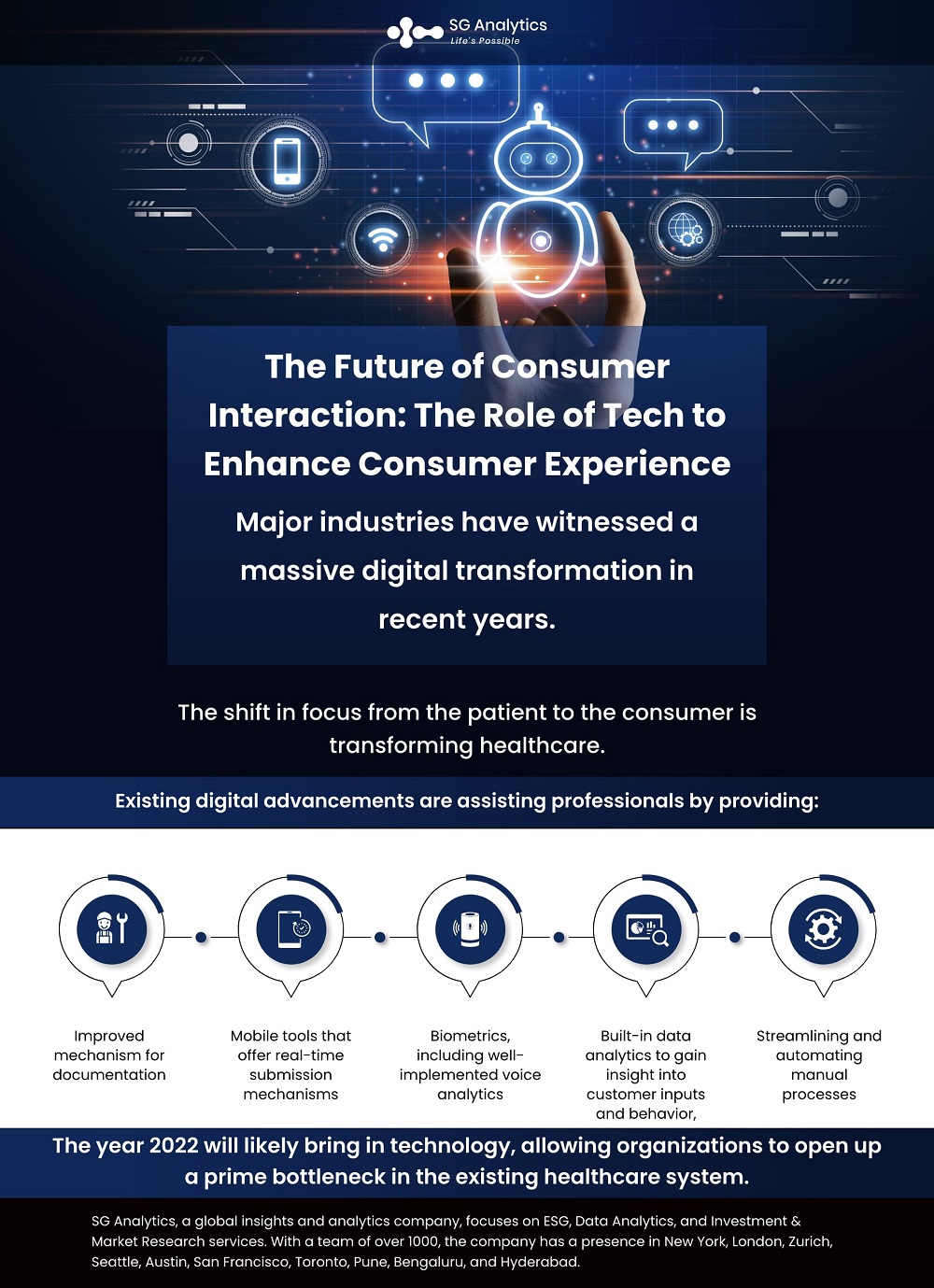Major industries have witnessed a massive digital transformation in recent years. Today consumer expectations and demands are setting the pace of progress in the consumer-driven market. Companies willing to take this digital leap of faith can better serve their customers and leapfrog over long-standing competitors, and drive change.
Digitization is revolutionizing the healthcare experience for consumers. The recent innovation is designed to complement the overall driving experience of a consumer. Digital technology is assisting organizations across different domains to improve their operations, revenue, compliance, claims, and underwriting efficiency, along with sales productivity and speed to market.
While digital innovation is becoming a norm in many industries around the world, the pandemic expedited the urgency to reposition to digital and – out of necessity – pushed many organizations into it faster than expected. Digital transformation is now enabling healthcare companies to meet new customer expectations along with enhancing work structures and improving their processes and profitability in this new world driven by new working norms.
Read more: Wearable Tech: A Promise to Revolutionize Healthcare

Organizations need to adapt to colliding forces to stay relevant as well as competitive in today’s marketplace. With emerging technologies, raised customer expectations for better experiences, and shareholder push to create loyalty gaining center stage, organizations are being forced to take into consideration the following:
-
How to improve customer as well as employee experience to create enduring relationships and sustainable value?
-
How to generate better outcomes for the patients and stakeholders, along with driving purposeful growth?
-
How to stay relevant and updated with the ever-changing customer needs and expectations?
-
Ways to eliminate friction points for customers to drive a more relevant, personalized experience
-
How to integrate technology and data to automate and orchestrate operations across all channels to improve customer experience?

Digital Revolution in Healthcare
Today a new term is entering as well as circling the healthcare lexicon. And that word is "consumer," as recently pointed out by Harvard Business Review. The article presented a clear differentiation between the term "patient" and "consumer."
While a patient is a term applied to a person who is receiving healthcare, a consumer is an individual who makes all the decisions about obtaining good care or service and then proceeds to obtain it.
In the past, healthcare providers were more focused on patients and the quality of the technical aspects of care instead of the consumers. This led to the creation of an almost denigration of the consumer aspects of health and healthcare, such as convenience, low cost, and friendly. However, healthcare is progressively moving to value-based care, where reimbursement elements are being tied to outcomes and patient satisfaction and where providers will be held accountable for the health-related decisions of consumers.

This shift in focus from the patient to the consumer is transforming healthcare, and healthcare payers are leading the way in many cases. Many healthcare organizations are now focusing on ways to incentivize people to stay healthy, which can be considered the ultimate in consumer satisfaction.
Read more: With Subscriber Rate Declining, What Does the Future Hold for Netflix?
Solving the Issue of Prior Authorization
Technology is often integrated into operations to enhance consumer satisfaction in healthcare. One such example of this is the rise in online medical portals where patients can check their lab results, make appointments, keep track of their medications, and much more. Patient or consumer satisfaction declines when low-tech processes are still predominant, like prior authorization, which is a paramount requirement by both government and commercial healthcare payment plans.
This is burdensome because archaic technology is still dominating the prior authorization process. As per the report issued by the Council for Affordable Quality Healthcare (CAQH), only 26% of prior authorization requests were converted into electronic in 2020, whereas an overwhelming 74% were still handled via telephone or fax.

In addition to the direct cost of obtaining and managing prior authorizations, there are consequential capacity utilization costs. To avoid downstream denials for the high-cost diagnostic and treatment services, healthcare organizations often require prior authorization. Health systems routinely reschedule patients if the authorization has not been received 48 hours before the appointment schedule. However, it is rare for the organization to fill that slot on such short notice, due to which expensive equipment and highly trained clinicians are left idle.
While the impact of healthcare operations is significant, the negative effect on patients cannot be underestimated. It is usually stressful for patients when their physician orders specialized care, like MRI or CT scan. Add to that the frustrating as well as the confusing process that is created to obtain prior authorizations, which leads to delays in patients’ access to necessary care.
Read more: Anticipating the Unanticipated: Balancing Business Resilience in the new age of Innovation

Existing digital advancements are assisting professionals by providing:
-
Improved mechanism for documentation that aids in minimizing the back and forth, thereby saving time and improving customer satisfaction
-
Mobile tools offer real-time photo submission mechanisms for claims. The input controls within the apps help in driving completeness.
-
Biometrics, including well-implemented voice analytics, also aids in improving security for customer ease and operating efficiencies.
-
Marketing tools with built-in data analytics help in gaining insight into customer inputs and behavior, thus making it easier for organizations to identify customer needs and the possible opportunities to launch new products.
-
Monitoring ranges from telematics to smart devices. They offer critical decision-making data. These can include real-time driver behavior data for smart monitoring and application.
-
Aids in process streamlining and automation of manual processes for cost management and profitable growth.
When healthcare payers decided to move their insurance claims to a digital format, they were commended for undertaking that transformation. Now doing the same for prior authorization will likely do wonders for the patient as well as consumer experience. Replacing outdated technology at the heart of prior authorizations will be the first big step in reforming the process, thereby making quality healthcare more accessible to all. And the good news is that many forward-thinking healthcare providers are now paying the way.

Summing Up the Pulse
Healthcare industry professionals, as well as leadership, need to outline a framework using technology to handle prior authorization. At the same time, most of the advanced tech tools required to make this process more efficient already exist, and technology that does not can be easily worked on incorporating. However, even in such cases, the challenge lies in changing the ingrained habits and already existing traditional standard operating procedures in the healthcare system.
Read more: The Metaverse: How is it Revolutionizing the Way We Shop?
Here are a few tips to support the adoption of new technologies along with fostering the adoption of change management in an organization.
-
Identify the underlying, bite-sized pieces of the overall change to focus on. Leadership must understand the necessity for enterprise-wide systematic changes. However, when rolling out modifications, it is vital to start with smaller steps to get the employees on board.
-
Facilitate clarity regarding the new tasks as well as behaviors that are desired.
-
Leadership must proactively verbalize that innovation is the need of the hour. It is important to explore ways to reward ideas that employees contribute to and design annual performance evaluations and goals around innovation. Employees will be able to respond to their performance evaluations.
To improve the electronic exchange of health care data as well as to streamline processes related to prior authorization, the healthcare industry is seeking solutions. In fact, the Centers for Medicare & Medicaid Services (CMS) has started working to change the existing policies for government-sponsored healthcare plans to reduce the use of fax technology across all programs and bring in a digital revolution.
With CMS leading the way, perhaps the year 2022 will likely bring in technology that will allow organizations to open a prime bottleneck in the existing healthcare system.
With a presence in New York, San Francisco, Austin, Seattle, Toronto, London, Zurich, Pune, Bengaluru, and Hyderabad, SG Analytics, a pioneer in Research and Analytics, offers tailor-made services to enterprises worldwide.
A leader in the Technology domain, SG Analytics partners with global technology enterprises across market research and scalable analytics. Contact us today if you are in search of combining market research, analytics, and technology capabilities to design compelling business outcomes driven by technology.









